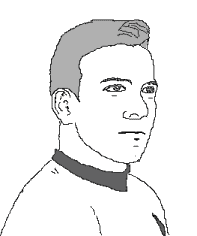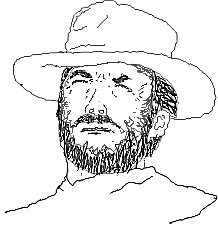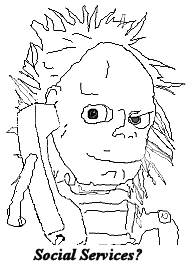 It’s not uncommon for philosophers of mind to refer enviously or scathingly to the transporter they used to have on board the U.S.S. Enterprise, which could dematerialise people in one place and then reconstitute them with exquisite accuracy in some other, distant place. I assume that the way this worked was that the transporter produced a comprehensive physical description of say, Kirk, which was then sent off to the destination and somehow used as the basis of a perfect reconstruction. I’m not sure modern physics allows this sort of thing, though I’ve seen articles which suggest it does, at least on a small scale.
It’s not uncommon for philosophers of mind to refer enviously or scathingly to the transporter they used to have on board the U.S.S. Enterprise, which could dematerialise people in one place and then reconstitute them with exquisite accuracy in some other, distant place. I assume that the way this worked was that the transporter produced a comprehensive physical description of say, Kirk, which was then sent off to the destination and somehow used as the basis of a perfect reconstruction. I’m not sure modern physics allows this sort of thing, though I’ve seen articles which suggest it does, at least on a small scale.
Whatever the physics, the device raises many practical questions. Why didn’t they just transport to places, instead of using a spaceship? Or if that was impossible, why not store crew and equipment as data, and reconstitute them only when needed? Why did they use photon torpedos when a transporter could presumably have scrambled the atoms of any Klingon ship at the press of a button? I’m sure there are good answers to all these questions, but the one that attracts the attention of philosophers is: was the person who arrived on the planet’s surface the same James T. Kirk who stepped into the transporter aboard the Enterprise ?
 Of course it would have been the same person! Think of this – every molecule in Kirk’s body gets changed time and again through the normal processes of human metabolism. When he gets reconstructed on the planet’s surface, it’s really no different- he’s just put together from a different set of elementary particles. If the actual particles were what mattered, his identity would be changing all the time as his cells rebuilt themselves from the new molecules derived from his food. When we’re talking about identity, it’s the form and causal relations that matter, not the actual physical stuff – and the transporter reproduces them perfectly.
Of course it would have been the same person! Think of this – every molecule in Kirk’s body gets changed time and again through the normal processes of human metabolism. When he gets reconstructed on the planet’s surface, it’s really no different- he’s just put together from a different set of elementary particles. If the actual particles were what mattered, his identity would be changing all the time as his cells rebuilt themselves from the new molecules derived from his food. When we’re talking about identity, it’s the form and causal relations that matter, not the actual physical stuff – and the transporter reproduces them perfectly.
 That’s all very well, but consider this: if the transporter malfunctions, it can produce two copies of Kirk. Now if there’s one thing that’s certain about personal identity, it’s that each person only gets one – so how can there be two? For that matter, Kirk’s descendants could pick up the echoes of the transporter beam from deep space long after he’s dead and reconstruct a dozen copies – they can’t all be him, can they?
That’s all very well, but consider this: if the transporter malfunctions, it can produce two copies of Kirk. Now if there’s one thing that’s certain about personal identity, it’s that each person only gets one – so how can there be two? For that matter, Kirk’s descendants could pick up the echoes of the transporter beam from deep space long after he’s dead and reconstruct a dozen copies – they can’t all be him, can they?
Excuse me interrupting, chaps, but can I introduce another idea? You both seem to be atheists, but most people have always attributed personal identity to an immaterial soul or spirit. Could it be that the question is essentially whether the transporter moves Kirk’s soul along with his body?
 I am not an atheist. In my view, faith and science are different levels of discourse, rather than contradictory accounts – but they do ultimately address the same world. We know that physical events can have spiritual consequences – to take a crude example, a blow on the head can effectively separate your soul from your body. I therefore don’t have any problem with the idea that if Kirk’s physical body were moved by the transporter, his soul would follow. What I challenge is the view that what the transporter does is transport , rather than duplicate.
I am not an atheist. In my view, faith and science are different levels of discourse, rather than contradictory accounts – but they do ultimately address the same world. We know that physical events can have spiritual consequences – to take a crude example, a blow on the head can effectively separate your soul from your body. I therefore don’t have any problem with the idea that if Kirk’s physical body were moved by the transporter, his soul would follow. What I challenge is the view that what the transporter does is transport , rather than duplicate.
 So once again the spiritual hypothesis turns out to be null – adding nothing to the physical account. But look, in your example, why shouldn’t all the copies be Kirk? I’m not suggesting they go on being the same person after the split, but they all have an equal claim to Kirk’s causal history – they’ve all got his memories and his characteristics. So they’re all Kirk: it’s just that Kirk split into several people. I see that that might cause legal difficulties over his property, but so what?
So once again the spiritual hypothesis turns out to be null – adding nothing to the physical account. But look, in your example, why shouldn’t all the copies be Kirk? I’m not suggesting they go on being the same person after the split, but they all have an equal claim to Kirk’s causal history – they’ve all got his memories and his characteristics. So they’re all Kirk: it’s just that Kirk split into several people. I see that that might cause legal difficulties over his property, but so what?
The point is, in the final analysis Kirk’s identity is a set of data like anything else, and data doesn’t care about the details of the medium it’s recorded in, so long as there is functional equivalence! On your view, Kirk’s identity depends on the identity of the atoms which make up his body – but do atoms have identities? aren’t they just maths, in the final analysis?
 The irony here is that you claim to be more of a materialist than me, yet you want Kirk to be some mathematical abstraction, or some kind of program, whereas I insist that he is a physical object – and that if you disperse that object, he dies. Of course he grows and changes in the normal course of events, but brute physical continuity is what matters.
The irony here is that you claim to be more of a materialist than me, yet you want Kirk to be some mathematical abstraction, or some kind of program, whereas I insist that he is a physical object – and that if you disperse that object, he dies. Of course he grows and changes in the normal course of events, but brute physical continuity is what matters.
If your view were true, then Kirk’s consciousness would have to split in order to go with each of his duplicates – but I ask you, isn’t it obvious that consciousness is essentially unitary? My consciousness can come and go, but the idea that it could split is simply unimaginable, isn’t it?
 Not to me. Anyway, some people find death unimaginable – doesn’t mean it won’t happen…
Not to me. Anyway, some people find death unimaginable – doesn’t mean it won’t happen…
 But if Kirk’s identity and consciousness are merely data, then they don’t really have a substantial existence. If he’s just data, then he exists just as much in the unreconstructed transporter signal as in the reconstruction – the fact that the machine has run up a physical instance of the data isn’t that important. And actually, even the signal doesn’t matter that much, since the numbers don’t actually depend on the signal for their existence – they exist in some Platonic sphere, anyway. But that’s true of all the possible sets of data. So on your view, there’s no real difference between people who do exist and those who don’t but might have…
But if Kirk’s identity and consciousness are merely data, then they don’t really have a substantial existence. If he’s just data, then he exists just as much in the unreconstructed transporter signal as in the reconstruction – the fact that the machine has run up a physical instance of the data isn’t that important. And actually, even the signal doesn’t matter that much, since the numbers don’t actually depend on the signal for their existence – they exist in some Platonic sphere, anyway. But that’s true of all the possible sets of data. So on your view, there’s no real difference between people who do exist and those who don’t but might have…
 Frankly I think you’re a little confused….
Frankly I think you’re a little confused….


